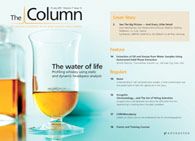Food contamination test
Responding to widespread recalls of potentially harmful phthalate?tainted food and beverages in Asia, AB Sciex has provided food safety investigators with a new method to identify the harmful plasticizer.
Responding to widespread recalls of potentially harmful phthalate‑tainted food and beverages in Asia, AB Sciex has provided food safety investigators with a new method to identify the harmful plasticizer.
Phthalate was recently found in Taiwan, in clouding agents commonly used in products including fruit jelly juices, sports drinks and yoghurt mix powder. Public reports allege that one or more food manufacturers had added this banned industrial plasticizer to an emulsifier as a cheap substitute for palm oil.
“AB Sciex continues to play an active role in assisting government agencies and food producers to ensure a safe food supply. If a contaminant is in food or beverages, our QTRAP and SelexION technologies are more than capable of pushing the limits of detection to identify and quantify it,” said Joe Anacleto, the company’s vice president and general manager of the Applied Markets and Clinical Research Business.
The method is designed to increase the accuracy and reduce the time to identify the contaminant from hours to minutes. This method is based on tandem mass spectrometry and, according to the company; this is the first available method to test for this toxic-additive with this technology. The company claims this is an advancement over other techniques, such as gas chromatography-mass spectrometry, which requires extensive sample preparation and longer run times.
For more information, visit www.absciex.com
This story originally appeared in The Column. Click here to view that issue.
Analytical Challenges in Measuring Migration from Food Contact Materials
November 2nd 2015Food contact materials contain low molecular weight additives and processing aids which can migrate into foods leading to trace levels of contamination. Food safety is ensured through regulations, comprising compositional controls and migration limits, which present a significant analytical challenge to the food industry to ensure compliance and demonstrate due diligence. Of the various analytical approaches, LC-MS/MS has proved to be an essential tool in monitoring migration of target compounds into foods, and more sophisticated approaches such as LC-high resolution MS (Orbitrap) are being increasingly used for untargeted analysis to monitor non-intentionally added substances. This podcast will provide an overview to this area, illustrated with various applications showing current approaches being employed.

.png&w=3840&q=75)

.png&w=3840&q=75)



.png&w=3840&q=75)



.png&w=3840&q=75)







